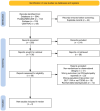Microvascular Outcomes of Glucagon-Like Peptide-1 (GLP-1) Receptor Agonists in Type 2 Diabetes: A Systematic Review of Retinopathy and Nephropathy Evidence
- PMID: 41141089
- PMCID: PMC12547187
- DOI: 10.7759/cureus.92976
Microvascular Outcomes of Glucagon-Like Peptide-1 (GLP-1) Receptor Agonists in Type 2 Diabetes: A Systematic Review of Retinopathy and Nephropathy Evidence
Abstract
This systematic review evaluated randomized controlled trials examining the effects of glucagon-like peptide-1 (GLP-1) receptor agonists on microvascular outcomes in type 2 diabetes, focusing on diabetic retinopathy and nephropathy. Four eligible RCTs, enrolling over 27,000 patients with follow-up periods ranging from 32 weeks to 5.4 years, were included. GLP-1 receptor agonists consistently demonstrated renal protective effects, primarily driven by reductions in new or worsening nephropathy and macroalbuminuria, with more modest and inconsistent effects on estimated glomerular filtration rate (eGFR) decline. In contrast, their impact on retinopathy remained inconclusive. A transient signal of worsening retinopathy has been reported in the context of rapid glycemic improvement; however, across large outcome trials, effects on retinopathy have been inconsistent and remain inconclusive. Overall, the evidence for retinopathy risk is limited by small event numbers, heterogeneity in assessments, and exploratory analyses. The certainty of renal benefit was strengthened by rigorous trial designs and low risk of bias, whereas retinopathy outcomes were generally secondary and less robust. These findings suggest that GLP-1 receptor agonists can be prioritized for patients at high renal risk, but careful monitoring of individuals with pre-existing retinopathy remains warranted.
Keywords: diabetic nephropathy; diabetic retinopathy; glp-1 receptor agonists; microvascular complications; randomized controlled trials; type 2 diabetes.
Copyright © 2025, Arif et al.
Conflict of interest statement
Conflicts of interest: In compliance with the ICMJE uniform disclosure form, all authors declare the following: Payment/services info: All authors have declared that no financial support was received from any organization for the submitted work. Financial relationships: All authors have declared that they have no financial relationships at present or within the previous three years with any organizations that might have an interest in the submitted work. Other relationships: All authors have declared that there are no other relationships or activities that could appear to have influenced the submitted work.
Figures
References
-
- Renal disease in patients with type 2 diabetes: magnitude of the problem, risk factors and preventive strategies. Gnudi L. Presse Med. 2023;52:104159. - PubMed
-
- Glycaemic control and macrovascular and microvascular outcomes: a systematic review and meta-analysis of trials investigating intensive glucose-lowering strategies in people with type 2 diabetes. Kunutsor SK, Balasubramanian VG, Zaccardi F, Gillies CL, Aroda VR, Seidu S, Khunti K. Diabetes Obes Metab. 2024;26:2069–2081. - PubMed
Publication types
LinkOut - more resources
Full Text Sources
Research Materials
Miscellaneous

